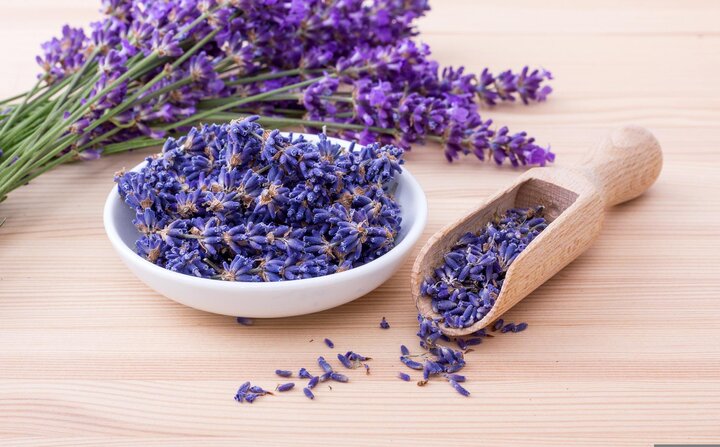Mary Jane Frogge, Nebraska Extension Associate

The wonderful smell of rose petals are a great addition to potpourri. Pictures by Pixabay.com.
Potpourris smell good and are easy to make. Many of the ingredients can be found in your yard or kitchen. There are many things you can put in potpourri. Use what you have available.

Plants to Use
- Dried flower petals from flowers such as roses, lavender, violets, peonies, marigold, statice and strawflowers.
- Dried leaves from lavender, mint, rosemary, arborvitae and junipers or eastern red cedar.
- Other things to collect and dry: flower pods, juniper berries, orange peel and small pine cones.
Directions
Dry the flower petals, leaves and other items on a paper towel, old pie tin, cookie sheet or box lid. Make sure your items are spread out and not piled on each other. They will dry faster this way. It may take a few days to a few weeks for everything to be completely dry.
Other items that can be added to your potpourri are broken cinnamon sticks, whole cloves and whole allspice.
Mix your dried items in a large bowl or large zip lock bag.
Display your potpourri in a small bowl, open jar or in sachets.
Easy to Make Sachets
Supplies
- Need: 6 inch circles cut from fabric, 8 to 12 inch ribbons
- Put 1 or 2 spoonfuls of potpourri in center of fabric circles.
- Gather the material around the potpourri and tie the little bag with the ribbon
What is Potpourri?
Potpourris are aromatic mixtures of dried plant materials. Making your own is not only easy but inexpensive. The basics of potpourri are few: aromatic plant materials, thoroughly dried; decorative plant materials, thoroughly dried; other aromatic ingredients, such as whole spices, chips of pleasant-smelling wood and citrus peel; essential oils; and fixative, which combines with the essential oils to preserve their fragrance.
Except for the essential oils and fixative, most of the ingredients are free for the picking.
Because materials have to be collected and dried, potpourri making is not a spur-of-the-moment project. You can start accumulating the dried ingredients any time -- starting with needles from the Christmas tree or landscape prunings, a bouquet of Mother's Day roses, marigolds from the garden, Queen Anne's lace from the perennial garden, bittersweet berries from a backyard vine -- collect whenever the opportunity presents itself.
Plant Materials & Drying
You can use almost any plant material that you like for its scent, color or shape in potpourri. Whatever you use absolutely must be thoroughly dried so that your mixture doesn't mold. Examples of aromatic plant materials include rose petals, marigold flowers and foliage, scented geraniums, lavender, mints, fragrant herbs of all kinds and evergreen needles.
Dry these by air-drying or microwaving between paper towels and combine them with whole cloves or stick cinnamon, bits of cedar bark, or dried orange or lemon peel. Once dried, store the materials in tightly sealed glass containers -- plastic or metal may interact with the essential oils that contain the scent -- and protect them from heat and sunlight. Pint or quart canning jars make good storage containers.
Essential Oil & Fixative
To these ingredients, you'll add a few drops of a compatible essential oil. Oils give a stronger, more long-lasting scent than dried ingredients alone can provide.
The best known fixative is orris root, which should be available wherever you purchase your essential oils. It smells faintly of violets when fresh. It's sold in powder or chunk form. Chunks tend to be effective longer and can be used in sachets or pillows -- chunks can't sift through the fabric as the powdered form does.
You can even put the fixative, essential oil and other aromatic ingredients, such as spices and orange peel, in the jars some time before you complete your mixture so that the fixative can pick up their scents.
Assembling Your Potpourri
When you've accumulated or purchased all the desired materials, it's time to put your potpourri together. Use either a glass or ceramic bowl or a sturdy plastic bag. Follow a recipe or invent your own mixture, being sure to write down the ingredients and their quantities. Potpourri takes a while to develop its aroma, so by the time you decide you like what you made, you may have forgotten what you put into it.
Stir the mixture with a wooden spoon or shake it gently in the plastic bag. Then add it to your jars, along with fixative and essential oil, close and shake well. Label the containers, store them in a cool, dry place, and shake daily.
Potpourri needs to age for at least a month before it's ready for use and leaving it longer won't hurt. If the scent is weaker than you want, you can always drop extra oil on a little fixative, shake it in and age some more.
Potpourri is often placed in cloth bags to be hung in a closet, sewn into sachets to keep in drawers or placed in decorative glass jars with lids that can be opened to release the fragrance into the room. In the latter case, addition of decorative plant materials such as dried Queen Anne's lace flowers, strawflowers, dried berries, seedpods and tiny cones can make your potpourri interesting to the eye as well as pleasing to the nose.
Pictures by Pixabay.com